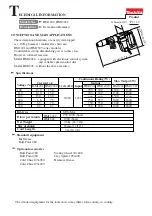
English
8
them to overheat and burst, resulting in personal injury,
property damage, fire, electric shock or electrocution.
•
Do not expose the charger to rain or snow.
•
Do not allow water or any liquid to enter charger.
•
Pull by the plug rather than the cord when
disconnecting the charger.
This will reduce the risk of
damage to the electric plug and cord.
•
Make sure that the cord is located so that it will not
be stepped on, tripped over or otherwise subjected to
damage or stress.
•
Do not use an extension cord unless it is absolutely
necessary.
Use of improper extension cord could result in
risk of fire, electric shock or electrocution.
•
When operating a charger outdoors, always provide
a dry location and use an extension cord suitable
for outdoor use.
Use of a cord suitable for outdoor use
reduces the risk of electric shock.
•
An extension cord must have adequate wire size
(AWG or American Wire Gauge) for safety.
The smaller
the gauge number of the wire, the heavier the cord and
thus the greater its capacity. An undersized cord will
cause a drop in line voltage resulting in loss of power and
overheating. The following table shows the correct size
to use depending on total length of all extension cords
plugged together, and nameplate ampere rating. If in
doubt, use the next heavier gauge.
Minimum gauge for Cord sets
Volts
Total length of Cord in Feet
(meters)
120V
25 (7.6)
50 (15.2) 100 (30.5) 150 (45.7)
Ampere Rating
American Wire gauge
More Than Not More
Than
0
6
18
16
16
14
6
10
18
16
14
12
10
12
16
16
14
12
12
16
14
12
Not Recommended
•
Do not place any object on top of the charger or place
the charger on a soft surface that might block the
ventilation slots and result in excessive internal heat.
Place the charger in a position away from any heat source.
The charger is ventilated through slots in the top and the
bottom of the housing.
•
Do not operate the charger with a damaged cord
or plug.
Have them replaced immediately.
•
Do not operate the charger if it has received a sharp
blow, been dropped or otherwise damaged in any
way.
Take it to an authorized service center.
•
Do not disassemble the charger; take it to an
authorized service center when service or repair
is required.
Incorrect reassembly may result in a risk of
electric shock, electrocution or fire.
•
The charger is designed to operate on standard
120V household electrical power. Do not attempt to
use it on any other voltage.
This does not apply to the
vehicular charger.
•
Foreign materials of a conductive nature, such as, but
not limited to, grinding dust, metal chips, steel wool,
Important Safety Instructions for All
Battery Chargers
WARNING: Read all safety warnings, instructions,
and cautionary markings for the battery pack,
charger and product. Failure to follow the
warnings and instructions may result in electric
shock, fire and/or serious injury.
•
DO NOT attempt to charge the battery pack with
any chargers other than a CRAFTSMAN charger.
CRAFTSMAN
chargers and battery packs are specifically
designed to work together.
•
These chargers are not intended for any uses other
than charging CRAFTSMAN rechargeable battery
packs.
Charging other types of battery packs may cause
The RBRC® Seal
Please take your spent battery packs to an
authorized CRAFTSMAN service center or
to your local retailer for recycling. In some
areas, it is illegal to place spent battery
packs in the trash. You may also contact your local recycling
center for information on where to drop off the spent
battery pack. Do not place in curbside recycling. For more
information visit
www.call2recycle.org
. or call the toll free
number in the RBRC® Seal.
RBRC® is a registered trademark of Call 2 Recycle, Inc
.
Storage Recommendations
The best storage place is one that is cool and dry, away
from direct sunlight and excess heat or cold. Store the fully
charged battery pack out of the charger.
Battery Pack Cleaning Instructions
Dirt and grease may be removed from the exterior of the
battery pack using a cloth or soft non‑metallic brush. Do not
use water or any cleaning solutions.
Fuel Gauge Battery Packs (Fig. B)
Some battery packs include a fuel gauge. When the fuel
gauge button is pressed and held, the LED lights will
indicate the approximate level of charge remaining. This
does not indicate tool functionality and is subject to
variation based on product components, temperature, and
end‑user application.
Transportation
WARNING:
Fire hazard. Do not store, carry, or
transport the battery pack so that metal objects
can contact exposed battery terminals.
For
example, do not place the battery pack in aprons,
pockets, tool boxes, product kit boxes, drawers, etc.,
with loose nails, screws, keys, coins, hand tools, etc.
When transporting individual battery packs, make
sure that the battery terminals are protected and well
insulated from materials that could contact them and
cause a short circuit.
NOTE:
Li‑ion battery packs should
not be put in checked baggage on airplanes and must
be properly protected from short circuits if they are in
carry‑on baggage.
Содержание CMCE565
Страница 5: ...English 3 11 12 Fig H ...
Страница 39: ...Español 37 ...











































